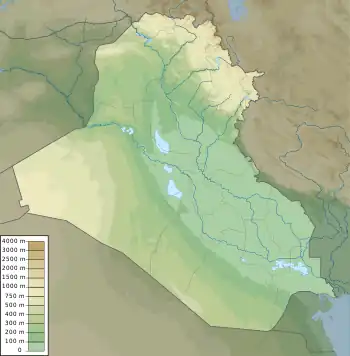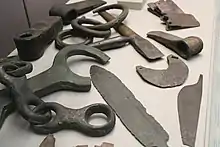Tell Sifr
Tell Sifr is an ancient Near East archaeological site in Dhi Qar Governorate Iraq. It lies about nine miles from the ancient city of Larsa. The city lay on a branch of the ancient Iturungal canal.
 Shown within Iraq | |
| Alternative name | Kutalla? |
|---|---|
| Location | Iraq |
| Coordinates | 31°17′33″N 45°57′57″E |
| Type | settlement |
| History | |
| Founded | c. 2000 BC |
| Periods | Bronze Age |
| Cultures | Old Babylonian |
| Site notes | |
| Excavation dates | 1854 |
| Archaeologists | William Loftus |
| Condition | Ruined |
| Ownership | Public |
| Public access | Yes |
History

The site was occupied in the Isin-Larsa and Old Babylonian periods. Larsa king Silli-Adad referred to himself as the governor of Kutalla.[1] In one of his writings Hammurabi refers to an orchard keeper from Kutalla.[2] A god, possibly the city god, known to reside at Kutallu was Lugal-ki-suna. A deified symbol of Marduk, Marru(m)-Ía-Marduk, the "Spade of Marduk" is also attested there.[3] In Parthian times it was used as a cemetery. The Parthian graves are brick vaulted oblongs and painted red inside.[4]
Archaeology

The site is a small conical mound on top of a platform of about 40 feet in height. It was excavated by William Loftus in 1854. A number of unbaked clay cuneiform tablets were found, many "enveloped". The tablets, 100 in total with most complete, were found in a brick structure, protected by reed matting. The envelopes partially surrounding the tablets were also inscribed and sealed using cylinder seals.[4] An Old Babylonian period assemblage of copper tools was found.
"large chaldrons, vases, small dislies, and dice-boxes (?); hammers, chisels, adzes, and hatchets; a large assortment of knives and daggers of various sizes and shapes—all unfinished; massive and smaller rings; a pair of prisoner's fetters ; three links of a strong chain; a ring weight; several plates resembling horses' shoes, divided at the heel for the insertion of a handle, and having; two holes in each for pins; other plates of a different shape, which were probably primitive hatchets; an ingot of copper, and a great weight of dross from the same smelted metal. There was likewise a small fragment of a bitumen bowl overlaid with thin copper; and a piece of lead."[4]
The copper assemblage, which had also been wrapped in reed matting, and the tablets are now held at the British Museum.[5][6] The tablets were later published. They were dated to the reigns of Larsa king Rim-Sin, and Babylon kings Hammurabi and Samsu-iluna. Most come from the family archive of one Sillii-Eshtar.[7][8] After further analysis it has been suggested that one third of the tablets actually came from Ur (excavated by J. E. Taylor) and were inadvertently mixed in with the Loftus tablets from Tell Sifr during shipping.[9][10]
See also
References
- De Graef, Katrien. "Bad Moon Rising: The Changing Fortunes of Early Second-Millennium BCE Ur". Ur in the Twenty-First Century CE: Proceedings of the 62nd Rencontre Assyriologique Internationale at Philadelphia, July 11–15, 2016, edited by Grant Frame, Joshua Jeffers and Holly Pittman, University Park, USA: Penn State University Press, 2021, pp. 49-88
- Westbrook, Raymond. "7. Social Justice in the Ancient Near East". Law from the Tigris to the Tiber: The Writings of Raymond Westbrook, edited by F. Rachel Magdalene and Bruce Wells, University Park, USA: Penn State University Press, 2021, pp. 143-160
- Frayne, Douglas R. and Stuckey, Johanna H.. A Handbook of Gods and Goddesses of the Ancient Near East: Three Thousand Deities of Anatolia, Syria, Israel, Sumer, Babylonia, Assyria, and Elam, University Park, USA: Penn State University Press, 2021
- William Loftus, Travels and researches in Chaldæa and Susiana; with an account of excavations at Warka, the Erech of Nimrod, and Shúsh, Shushan the Palace of Esther, in 1849-52, J. Nisbet and Co., 1857
- Moorey, P. R. S. "The Loftus Hoard of Old Babylonian Tools from Tell Sifr in Iraq." Iraq, vol. 33, no. 2, 1971, pp. 61–86
- Moorey, P. R. S., et al. “New Analyses of Old Babylonian Metalwork from Tell Sifr." Iraq, vol. 50, 1988, pp. 39–48
- C. F. Jean, "Tell Sifr. Textes cuneiformes conserves au British Museum", 1931
- Charpin, Dominique. Archives familiales et propriéte privée en Babylonie ancienne: étude des documents de" Tell Sifr". Vol. 12. Librairie Droz, 1980
- Charpin, Dominique. "CHAPTER 2. Outline for a Diplomatics of Mesopotamian Documents". Writing, Law, and Kingship in Old Babylonian Mesopotamia, Chicago: University of Chicago Press, 2010, pp. 25-42
- Charpin, Dominique. "Epigraphy of Ur: Past, Present, and Future". Ur in the Twenty-First Century CE: Proceedings of the 62nd Rencontre Assyriologique Internationale at Philadelphia, July 11–15, 2016, edited by Grant Frame, Joshua Jeffers and Holly Pittman, University Park, USA: Penn State University Press, 2021, pp. 181-194
Further reading
- R.Ward, The Family History of Silli-Ishtar: A Reconstruction based on the Kutalla Documents, University of Minnesota Unpublished PhD. Dissertation [Minneapolis, 1973